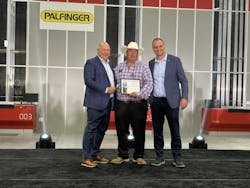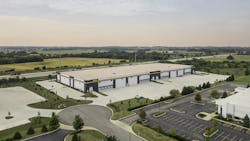Q&A: Why PALFINGER is investing in North America and its service business
Key Highlights
- The new parts distribution facility enables faster shipping and better inventory management for PALFINGER in North America, in order to double revenue in the coming years.
- Predictive maintenance using sensor technology and AI is a key focus, providing real-time data and maintenance insights for large fleet operators and machine design.
- The company is actively managing supply chain and tariff challenges by localizing components, diversifying sourcing, and leveraging its global manufacturing footprint to ensure stability.
Before the grand opening for PALFINGER’s new parts and distribution center for North America in Huntley, Illinois, PALFINGER CEO Andreas Klauser and Ismael Daneluz, vice president of sales & service at PALFINGER, sat down with the media to discuss how the new facility and its service and maintenance business will drive growth North America, the role of predictive maintenance for fleet management, and dealing with supply chain and tariff challenges.
“We are really committed to this region and very supported by Andreas and the whole board. Investing in North America is a key backbone for helping it to grow,” Daneluz said.
Service and maintenance business will drive revenue
The new $15 million U.S. parts distribution center will drive additional revenue on the service and maintenance side of the business in North America.
“If we want to be successful in the market, our service and our parts is a key point for uptime. Equipment cannot stop working. And that’s a big step and a big investment,” Daneluz said.
Premium service is as important to PALFINGER, as premium products and solutions. The company’s dealer network is a big part of that premium service. It has 130 authorized dealers that support more than 420 service locations across North America. “This means as well further training our dealers, so the entire dealer network will become more professional,” Klauser said.
Service can also help balance lulls in equipment sales. “You can still do a big portion out of the parts and service business, and we are ready to do so,” he said. PALFINGER wants to serve its customers long after the initial sale, and Klauser said, its customers like the strength of a global dealer network, combined with localized service support.
Equipment uptime for its customers is even more critical in North America, he said, where total cost of ownership (TCO) uptime is a clear KPI that guides customers’ product decisions.
“If you are a premium product, people expect premium service and premium treatment, and that’s why we are here,” Klauser said.
The new 177,000-square-foot parts distribution center for North America has a central U.S. location with easy access to air and ground cargo transportation via two airports and major cross-county interstates.
The role of predictive maintenance in fleet management
Predictive maintenance for PALFINGER equipment and machines will also be a priority for moving forward, Klauser said. The company uses sensor technology on, for instance, track mounted forklifts and knuckle boom cranes. This work is largely being done by PALFINGER overseas, but the skills and technology will find a home in North America too, Klauser adds.
PdM for PALFINGER is also supported by artificial intelligence (AI) to improve data analytics, Klauser said, while being careful not to overcomplicate processes for fleet operators and dealers. The company wants to strike a delicate balance between user friendly equipment and advanced technology.
“Our products have sensors now, and kinematics is a topic which is growing,” Daneluz said. PALFINGER is using and studying its machine data to make predictive analyses about machine failure, which will only grow in the future.
In 2025, PALFINGER released Connected, a central platform that includes telematics module and data transmission capabilities, which is standard on a wide range of machines and provides basic access to machine data, including customized dashboards, maintenance plans, and detailed operational information. Connected plus+ is the manufacturer’s subscription service that enables real-time data transfer.
“So many of our larger accounts that have big fleets, they need it,” Daneluz said. “This is already a must if you want to win the market.”
PALFINGER has also upgraded its virtual reality training program. “We are trying to make it easier for our dealers and for the customers to experience PALFINGER, and also to train in a safe environment and understand how the machine works and performs,” Daneluz said.
How PALFINGER manages supply chain and tariff challenges
With ongoing supply chain challenges and tariff complications, localizing components as much as possible becomes even more essential, Klauser said. While the U.S. facility also works largely with companies in Canada and Mexico, which, so far, have no current tariffs, the supply chain takes constant attention. The changing global trade landscape means additional focus on PALFINGER’s upstream (component suppliers) and downstream (customer product) supply chains.
“It’s complicated. It makes life a bit more difficult in terms of identifying how to bring our equipment in,” Klauser said. “It is more components? Is it more complete machines? This is on a daily basis, we are checking it out. But I think so far, we are dealing quite well.”
Read more about Palfinger's Action Park, where its work trucks were on display and open for a test drive.
In order to balance imposed tariffs from imported components, PALFINGER does export to Asia from the U.S. “This helps us, in that we’re getting credits for tariffs because we are doing exports,” Klauser said.
Volatility at PALFINGER is also eased by its sheer size, Daneluz said. With 30 manufacturing facilities worldwisde, supporting customers in more than 130 countries, its wide product range can largely withstand market ups and downs.
New parts distribution center will support doubling of parts revenue
Currently, one-quarter of PALFINGER’s revenue derives from North America, so this region is already a significant market for the company, which aims to further grow its footprint here. Since 2018 the company has grown revenues by nearly $1 billion without acquisitions on the existing product portfolio. “There are still opportunities,” Klauser said.
Of PALFINGER’s future revenue, which is forecasted to be around $3 billion, Klauser said, closer to 1/3 of that revenue will need to come out of North America. Equipment and machine sales alone will not be enough to support that revenue growth, and so parts and service will play a large part.
“We need to be closer to the marketplace, faster to the marketplace, and we need to be able to quite efficiently support and supply the marketplace,” Klauser said. “That’s why we are doing this $15 million investment here in a very modern warehouse and very modern parts operation.”
The new facility also means a bigger investment in parts inventory and the team to support that. “We are targeting to double our revenue of parts in the next few years,” Daneluz said.
About the Author

Anna Townshend
managing editor
Anna Townshend has been a journalist and editor for almost 20 years. She joined Control Design and Plant Services as managing editor in June 2020. Previously, for more than 10 years, she was the editor of Marina Dock Age and International Dredging Review. In addition to writing and editing thousands of articles in her career, she has been an active speaker on industry panels and presentations, as well as host for the Tool Belt and Control Intelligence podcasts. Email her at [email protected].



